
Trilobites are extinct marine arthropods that form the class Trilobita. Trilobites form one of the earliest known groups of arthropods. The first appearance of trilobites in the fossil record defines the base of the Atdabanian stage of the Early Cambrian period and they flourished throughout the lower Paleozoic before slipping into a long decline, when, during the Devonian, all trilobite orders except the Proetida died out. The last trilobites disappeared in the mass extinction at the end of the Permian about 251.9 million years ago. Trilobites were among the most successful of all early animals, existing in oceans for almost 270 million years, with over 22,000 species having been described.

Redlichiida is an order of trilobites, a group of extinct marine arthropods. Species assigned to the order Redlichiida are among the first trilobites to appear in the fossil record, about halfway during the Lower Cambrian. Due to the difficulty to relate sediments in different areas, there remains some discussion, but among the earliest are Fallotaspis, and Lemdadella, both belonging to this order. The first representatives of the orders Corynexochida and Ptychopariida also appear very early on and may prove to be even earlier than any redlichiid species. In terms of anatomical comparison, the earliest redlichiid species are probably ancestral to all other trilobite orders and share many primitive characters. The last redlichiid trilobites died out before the end of the Middle Cambrian.

Phacopidae is a family of phacopid trilobites that ranges from the Lower Ordovician to the Upper Devonian, with representatives in all paleocontinents.

Dalmanites is a genus of trilobite in the order Phacopida. They lived from the Late Ordovician to Middle Devonian.

Paradoxides is a genus of large to very large trilobite found throughout the world during the Middle Cambrian period. One record-breaking specimen of Paradoxides davidis, described by John William Salter in 1863, is 37 cm (15 in). The cephalon was semicircular with free cheeks ending in long, narrow, recurved spines. Eyes were crescent shaped providing an almost 360° view, but only in the horizontal plane. Its elongate thorax was composed of 19–21 segments and adorned with longish, recurved pleural spines. Its pygidium was comparatively small. Paradoxides is a characteristic Middle-Cambrian trilobite of the 'Atlantic' (Avalonian) fauna. Avalonian rocks were deposited near a small continent called Avalonia in the Paleozoic Iapetus Ocean. Avalonian beds are now in a narrow strip along the East Coast of North America, and in Europe.
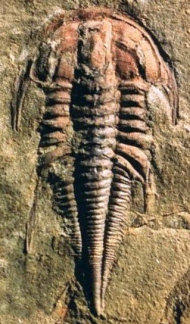
Emuellidae are a small family of trilobites, a group of extinct marine arthropods, that lived during the late Lower Cambrian of the East Gondwana supercontinent, in what are today South-Australia and Antarctica.

Huntoniatonia is genus of trilobites, an extinct group of marine arthropods of average to large size.

Dikelocephalus is a genus of very large trilobites of up to 50 cm (20 in) long, that lived during the last 3 million years of the Cambrian (Sunwaptan). Their fossils are commonly found as disarticulated sclerites, in the upper Mississippi Valley and in Canada (Alberta). The exoskeleton is rounded anteriorly, with the thorax and sides of the tailshield slightly tapering to about 2⁄3× of the width across the base of the spines at the back of the headshield. At the side corners of the pygidium there may be triangular or hooked spines, pointing backwards, while between the spines the posterior margin is at a 30-75° angle with the lateral margin, gently convex or nearly straight. If pygidial spines are lacking, the margin is gradually rounded. The thorax has 12 segments.
Meniscuchus is an extinct genus from a well-known class of fossil marine arthropods, the trilobites. It lived during the Botomian stage, which lasted from approximately 522 to 516 million years ago. This faunal stage was part of the Cambrian Period. Meniscuchus has been found in the USA, Canada, Russia and Australia.
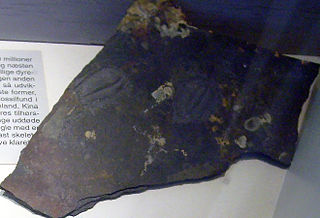
Buenellus higginsi is an average size trilobite, which lived during the Lower Cambrian period, in what is now North-West Greenland. It is a prominent member of the Sirius Passet fauna. Buenellus higginsi is the only known species in the genus Buenellus.

Meteoraspis is an extinct genus of ptychopariid trilobites of the family Tricrepicephalidae. The various species lived from 501 to 497 million years ago during the Dresbachian faunal stage of the late Cambrian Period. Fossils of Meteoraspis are characteristic of Late Cambrian strata in North America, though they are found in Late Cambrian strata elsewhere in the world, such as M. nevensis from Victoria Land, Antarctica.
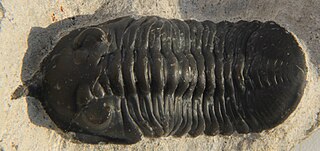
Morocconites malladoides is an average size trilobite, which lived during the Devonian period, in what is now southern Morocco. This species is assumed to be a close relative of Acastoides. The most conspicuous feature is the very long upcurved frontal medial spine, a bit like an avocet bill. It is the only known species in this genus.
The cephalon is the head section of an arthropod. It is a tagma, i.e., a specialized grouping of arthropod segments. The word cephalon derives from the Greek κεφαλή (kephalē), meaning "head".

Alokistocaridae is a family of ptychopariid trilobites that lived from the Botomian epoch of the Early Cambrian until the Late Cambrian. Alokistocarids were particle feeders and left small furrows which are occasionally preserved. Their remains are found worldwide. Elrathia kingii, one of the most collected trilobites in the world, is a typical alokistocarid.
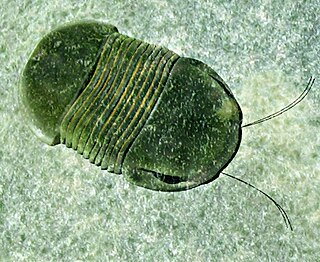
Bumastus is an extinct genus of corynexochid trilobites which existed from the Early Ordovician period to the Late Silurian period. They were relatively large trilobites, reaching a length of 6 in (15 cm). They were distinctive for their highly globular, smooth-surfaced exoskeleton. They possessed well-developed, large compound eyes and were believed to have dwelled in shallow-water sediments in life.

Biceratops is an extinct genus of olenelloid redlichiid trilobites, of average size, with the largest specimen 8 centimetres or 3.1 inches long, not including the huge pleural spines of the 3rd segment of the thorax. It lived during the Toyonian stage, in what is today the South-Western United States. Biceratops can easily be distinguished from other members of Biceratopsidae by the absence of genal spines, in combination with effaced features of the raised axial area of the head shield, that is bordering the two horn-like projections that carry the eyes. Biceratops nevadensis is the only known species in this genus.

Ptychoparia is a genus of ptychopariid trilobites, and is the type genus of the family Ptychopariidae, and the order Ptychopariida.
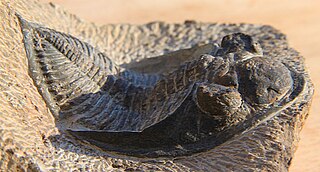
Odontochile is a genus of trilobites in the order Phacopida, family Dalmanitidae.

Psychopyge is a genus of trilobite, that lived during the upper Emsian and has been found in Germany and Morocco. It is characterized by the swordlike extension from the front of the head.

Tricrepicephalus is an extinct genus of ptychopariid trilobites of the family Tricrepicephalidae with species of average size. Its species lived from 501 to 497 million years ago during the Dresbachian faunal stage of the late Cambrian Period. Fossils of Tricrepicephalus are widespread in Late Cambrian deposits in North America, but is also known from one location in South America. Tricrepicephalus has an inverted egg-shaped exoskeleton, with three characteristic pits in the fold that parallels the margin of the headshield just in front of the central raised area. The articulating middle part of the body has 12 segments and the tailshield carries two long, tubular, curved pygidial spines that are reminiscent of earwig's pincers that rise backwards from the plain of the body at approximately 30°.


















